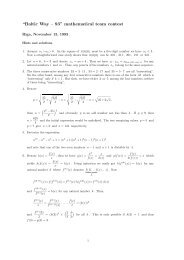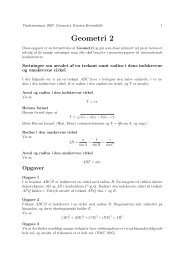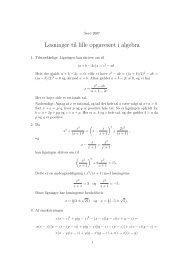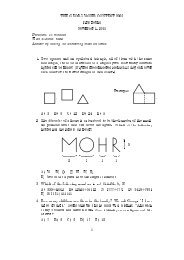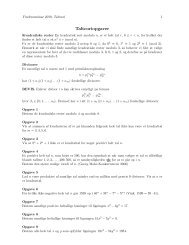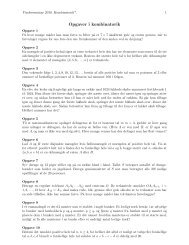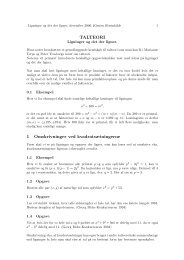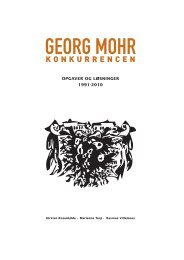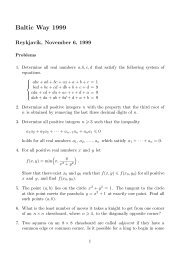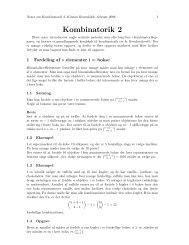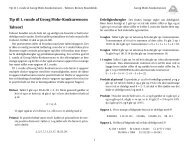Solution - Georg Mohr-Konkurrencen
Solution - Georg Mohr-Konkurrencen
Solution - Georg Mohr-Konkurrencen
- No tags were found...
You also want an ePaper? Increase the reach of your titles
YUMPU automatically turns print PDFs into web optimized ePapers that Google loves.
Baltic Way 2004Vilnius, November 7, 2004Problems and solutions1. Given a sequence a 1 , a 2 , a 3 , . . . of non-negative real numbers satisfying the conditions(1) a n + a 2n ≥ 3n(2) a n+1 + n ≤ 2 √ a n · (n + 1)for all indices n = 1, 2 . . ..(a) Prove that the inequality a n ≥ n holds for every n ∈ N.(b) Give an example of such a sequence.<strong>Solution</strong>: (a) Note that the inequalitya n+1 + n2≥ √ a n+1 · nholds, which together with the second condition of the problem gives√√an+1 · n ≤ a n · (n + 1).This inequality simplifies toa n+1a n≤ n + 1n .Now, using the last inequality for the index n replaced by n, n + 1, . . . , 2n − 1 andmultiplying the results, we obtaina 2na n≤ 2n n = 2or 2a n ≥ a 2n . Taking into account the first condition of the problem, we have3a n = a n + 2a n ≥ a n + a 2n ≥ 3nwhich implies a n ≥ n. (b) The sequence defined by a n = n + 1 satisfies all the conditionsof the problem.2. Let P(x) be a polynomial with non-negative coefficients. Prove that if P( 1 x)P(x) ≥ 1 forx = 1, then the same inequality holds for each positive x.<strong>Solution</strong>: For x > 0 we have P(x) > 0 (because at least one coefficient is non-zero). Fromthe given condition we have (P(1)) 2 ≥ 1. Further, let’s denote P(x) = a n x n + a n−1 x n−1 +· · · + a 0 . ThenP(x)P( 1 x ) = (a nx n + · · · + a 0 )(a n x −n + · · · + a 0 )=≥n∑i=0n∑i=0a 2 i +n i−1∑ ∑i=1 j=0a 2 i + 2 ∑ a i a ji>j= (P(1)) 2 ≥ 1.(a i−j a j )(x i + x −i )1
3. Let p, q, r be positive real numbers and n ∈ N. Show that if pqr = 1, then1p n + q n + 1 + 1q n + r n + 1 + 1r n + p n + 1 ≤ 1.<strong>Solution</strong>: The key idea is to deal with the case n = 3. Put a = p n/3 , b = q n/3 , andc = r n/3 , so abc = (pqr) n/3 = 1 andNowSince ab = c −1 ,Similarly we obtainHence1p n +q n +1 + 1q n +r n +1 + 1r n +p n +1 = 1a 3 +b 3 +1 + 1b 3 +c 3 +1 + 1c 3 +a 3 +1 .1a 3 +b 3 +1 = 1(a+b)(a 2 −ab+b 2 )+1 = 1(a+b)((a−b) 2 +ab)+1 ≤ 1(a+b)ab+1 .1b 3 +c 3 +1 ≤which was to be shown.1a 3 +b 3 +1 ≤ 1(a+b)ab+1 =ca+b+c .a1a+b+candc 3 +a 3 +1 ≤1a 3 +b 3 +1 + 1b 3 +c 3 +1 + 1c 3 +a 3 +1 ≤ca+b+c +aa+b+c +ba+b+c .ba+b+c = 1,4. Let x 1 , x 2 , . . . , x n be real numbers with arithmetic mean X. Prove that there is a positiveinteger K such that the arithmetic mean of each of the lists {x 1 , x 2 , . . . , x K }, {x 2 , x 3 , . . . , x K },. . . , {x K−1 , x K }, {x K } is not greater than X.<strong>Solution</strong>: Suppose the conclusion is false. This means that for every K ∈ {1, 2, . . . , n},there exists a k ≤ K such that the arithmetic mean of x k , x k+1 , . . . , x K exceeds X. Wenow define a decreasing sequence b 1 ≥ a 1 > a 1 − 1 = b 2 ≥ a 2 > · · · as follows: Putb 1 = n, and for each i, let a i be the largest largest k ≤ b i such that the arithmetic meanof x ai , . . . , x bi exceeds X; then put b i+1 = a i − 1 and repeat. Clearly for some m, a m = 1.Now, by construction, each of the sets {x am , . . . , x bm }, {x am−1 , . . . , x bm−1 }, . . . , {x a1 , . . . , x b1 }has arithmetic mean strictly greater than X, but then the union {x 1 , x 2 , . . . , x n } of thesesets has arithmetic mean strictly greater than X; a contradiction.5. Determine the range of the function f defined for integers k byf (k) = (k) 3 + (2k) 5 + (3k) 7 − 6k,where (k) 2n+1 denotes the multiple of 2n + 1 closest to k.<strong>Solution</strong>: For odd n we have(k) n = k + n − 12− [ k + n − 1 ]2 n ,where [m] n denotes the principal remainder of m modulo n. Hence we getf (k) = 6 − [k + 1] 3 − [2k + 2] 5 − [3k + 3] 7 .2
The condition that the principal remainders take the values a, b and c, respectively, maybe writtenk + 1 ≡ a (mod 3),2k + 2 ≡ b (mod 5),3k + 3 ≡ c (mod 7)ork ≡ a − 1 (mod 3),k ≡ −2b − 1 (mod 5),k ≡ −2c − 1 (mod 7).By the Chinese Remainder Theorem, these congruences have a solution for any set ofa, b, c. Hence f takes all the integer values between 6 − 2 − 4 − 6 = −6 and 6 − 0 − 0 − 0 =6. (In fact, this proof also shows that f is periodic with period 3 · 5 · 7 = 105.)6. A positive integer is written on each of the six faces of a cube. For each vertex of the cube wecompute the product of the numbers on the three adjacent faces. The sum of these products is1001. What is the sum of the six numbers on the faces?<strong>Solution</strong>: Let the numbers on the faces be a 1 , a 2 , b 1 , b 2 , c 1 , c 2 , placed so that a 1 and a 2are on opposite faces etc. Then the sum of the eight products is equal to(a 1 + a 2 )(b 1 + b 2 )(c 1 + c 2 ) = 1001 = 7 · 11 · 13.Hence the sum of the numbers on the faces is a 1 + a 2 + b 1 + b 2 + c 1 + c 2 = 7 + 11 + 13 =31.7. Find all sets X consisting of at least two positive integers such that for every pair m, n ∈ X,where n > m, there exists k ∈ X such that n = mk 2 .Answer: The sets {m, m 3 }, where m > 1.<strong>Solution</strong>: Let X be a set satisfying the condition of the problem and let n > m be thetwo smallest elements in the set X. There has to exist a k ∈ X so that n = mk 2 , but asm ≤ k ≤ n, either k = n or k = m. The first case gives m = n = 1, a contradiction; thesecond case implies n = m 3 with m > 1.Suppose there exists a third smallest element q ∈ X. Then there also exists k 0 ∈ X,such that q = mk 2 0 . We have q > k 0 ≥ m, but k 0 = m would imply q = n, thusk 0 = n = m 3 and q = m 7 . Now for q and n there has to exist k 1 ∈ X such that q = nk 2 1 ,which gives k 1 = m 2 . Since m 2 ̸∈ X, we have a contradiction.Thus we see that the only possible sets are those of the form {m, m 3 } with m > 1,and these are easily seen to satisfy the conditions of the problem.8. Let f be a non-constant polynomial with integer coefficients. Prove that there is an integer nsuch that f (n) has at least 2004 distinct prime factors.<strong>Solution</strong>: Suppose the contrary. Choose an integer n 0 so that f (n 0 ) has the highestnumber of prime factors. By translating the polynomial we may assume n 0 = 0. Settingk = f (0), we have f (wk 2 ) ≡ k (mod k 2 ), or f (wk 2 ) = ak 2 + k = (ak + 1)k. Sincegcd(ak + 1, k) = 1 and k alone achieves the highest number of prime factors of f , wemust have ak + 1 = ±1. This cannot happen for every w since f is non-constant, so wehave a contradiction.9. A set S of n − 1 natural numbers is given (n ≥ 3). There exists at least two elements in thisset whose difference is not divisible by n. Prove that it is possible to choose a non-empty subset ofS so that the sum of its elements is divisible by n.3
<strong>Solution</strong>: Suppose to the contrary that there exists a set X = {a 1 , a 2 , . . . , a n−1 } violatingthe statement of the problem, and let a n−2 ̸≡ a n−1 (mod n). Denote S i = a 1 + a 2 +· · · + a i , i = 1, . . . , n − 1. The conditions of the problem imply that all the numbers S imust give different remainders when divided by n. Indeed, if for some j < k we hadS j ≡ S k (mod n), then a j+1 + a j+2 + · · · + a k = S k − S j ≡ 0 (mod n). Consider now thesum S ′ = S n−3 + a n−1 . We see that S ′ can not be congruent to any of the sums S i (fori ̸= n − 2 the above argument works and for i = n − 2 we use the assumption a n−2 ̸≡ a n−1(mod n)). Thus we have n sums that give pairwise different remainders when dividedby n, consequently one of them has to give the remainder 0, a contradiction.10. Is there an infinite sequence of prime numbers p 1 , p 2 , . . . such that |p n+1 − 2p n | = 1 for eachn ∈ N?Answer: No, there is no such sequence.<strong>Solution</strong>: Suppose the contrary. Clearly p 3 > 3. There are two possibilities: If p 3 ≡ 1(mod 3) then necessarily p 4 = 2p 3 − 1 (otherwise p 4 ≡ 0 (mod 3)), so p 4 ≡ 1 (mod 3).Analogously p 5 = 2p 4 − 1, p 6 = 2p 5 − 1 etc. By an easy induction we havep n+1 − 1 = 2 n−2 (p 3 − 1), n = 3, 4, 5, . . . .If we set n = p 3 + 1 we have p p3 +2 − 1 = 2 p 3−1 (p 3 − 1), from whichp p3 +2 ≡ 1 + 1 · (p 3 − 1) = p 3 ≡ 0 (mod p 3 ),a contradiction. The case p 3 ≡ 2 (mod 3) is treated analogously.11. An m × n table is given, in each cell of which a number +1 or −1 is written. It is knownthat initially exactly one −1 is in the table, all the other numbers being +1. During a move, it isallowed to choose any cell containing −1, replace this −1 by 0, and simultaneously multiply allthe numbers in the neighboring cells by −1 (we say that two cells are neighboring if they have acommon side). Find all (m, n) for which using such moves one can obtain the table containingzeroes only, regardless of the cell in which the initial −1 stands.Answer: Those (m, n) for which at least one of m, n is odd.<strong>Solution</strong>: Let us erase a unit segment which is the common side of any two cells inwhich two zeroes appear. If the final table consists of zeroes only, all the unit segments(except those which belong to the boundary of the table) are erased. We must erase atotal ofm(n − 1) + n(m − 1) = 2mn − m − nsuch unit segments.On the other hand, in order to obtain 0 in a cell with initial +1 one must firstobtain −1 in this cell, that is, the sign of the number in this cell must change an oddnumber of times (namely, 1 or 3). Hence, any cell with −1 (except the initial one) hasan odd number of neighboring zeroes. So, any time we replace −1 by 0 we erase anodd number of unit segments. That is, the total number of unit segments is congruentmodulo 2 to the initial number of +1’s in the table. Therefore 2mn − m − n ≡ mn − 1(mod 2), implying that (m − 1)(n − 1) ≡ 0 (mod 2), so at least one of m, n is odd.It remains to show that if, for example, n is odd, we can obtain a zero table. First,if −1 is in the i’th row, we may easily make the i’th row contain only zeroes, while itsone or two neighboring rows contain only −1’s. Next, in any row containing only −1’s,we first change the −1 in the odd-numbered columns (that is, the columns 1, 3, . . . , n)to zeroes, resulting in a row consisting of alternating 0 and −1 (since the −1’s in the4
even-numbered columns have been changed two times), and we then easily obtain anentire row of zeroes. The effect of this on the next neighboring row is to create a newrow of −1’s, while the original row is clearly unchanged. In this way we finally obtain azero table.12. There are 2n different numbers in a row. By one move we can interchange any two numbersor interchange any three numbers cyclically (choose a, b, c and place a instead of b, b instead of cand c instead of a). What is the minimal number of moves that is always sufficient to arrange thenumbers in increasing order?<strong>Solution</strong>: If a number y occupies the place where x should be at the end, we draw anarrow x → y. Clearly at the beginning all numbers are arranged in several cycles: Loops• , binary cycles • ⇄ • and “long” cycles (at least three numbers). Our aim isto obtain 2n loops.Clearly each binary cycle can be rearranged into two loops by one move. If there is along cycle with a fragment · · · → a → b → c → · · · , interchange a, b, c cyclically so thatat least two loops, a , b , appear. By each of these moves, the number of loops increaseby 2, so at most n moves are needed.On the other hand, by checking all possible ways the two or three numbers canbe distributed among disjoint cycles, it is easy to see that each of the allowed movesincreases the number of disjoint cycles by at most two. Hence if the initial situation isone single loop, at least n moves are needed.13. The 25 member states of the European Union set up a committee with the following rules:(1) the committee should meet daily; (2) at each meeting, at least one member state shouldbe represented; (3) at any two different meetings, a different set of member states should berepresented; and (4) at the n’th meeting, for every k < n, the set of states represented shouldinclude at least one state that was represented at the k’th meeting. For how many days can thecommittee have its meetings?Answer: At most 2 24 = 16777216 days.<strong>Solution</strong>: If one member is always represented, rules 2 and 4 will be fulfilled. There are2 24 different subsets of the remaining 24 members, so there can be at least 2 24 meetings.Rule 3 forbids complementary sets at two different meetings, so the maximal numberof meetings cannot exceed 1 2 · 225 = 2 24 . So the maximal number of meetings for thecommittee is exactly 2 24 = 16777216.14. We say that a pile is a set of four or more nuts. Two persons play the following game. Theystart with one pile of n ≥ 4 nuts. During a move a player takes one of the piles that they haveand split it into two non-empty subsets (these sets are not necessarily piles, they can contain anarbitrary number of nuts). If the player cannot move, he loses. For which values of n does the firstplayer have a winning strategy?Answer: The first player has a winning strategy when n ≡ 0, 1, 2 (mod 4); otherwise thesecond player has a winning strategy.<strong>Solution</strong>: Let n = 4k + r, where 0 ≤ r ≤ 3. We will prove the above answer by inductionon k; clearly it holds for k = 1. We are also going to need the following useful fact:If at some point there are exactly two piles with 4s + 1 and 4t + 1 nuts,s + t ≤ k, then the second player to move from that point wins.This holds vacuously when k = 1.Now assume that we know the answer when the starting pile consists of at most4k − 1 nuts, and that the useful fact holds for s + t ≤ k. We will prove the answer is5
correct for 4k, 4k + 1, 4k + 2 and 4k + 3, and that the useful fact holds for s + t ≤ k + 1.For the sake of bookkeeping, we will refer to the first player as A and the second playeras B.If the pile consists of 4k, 4k + 1 or 4k + 2 nuts, A simply makes one pile consistingof 4k − 1 nuts, and another consisting of 1, 2 or 3 nuts, respectively. This makes A thesecond player in a game starting with 4k − 1 ≡ 3 (mod 4) nuts, so A wins.Now assume the pile contains 4k + 3 nuts. A can split the pile in two ways: Eitheras (4p + 1, 4q + 2) or (4p, 4q + 3). In the former case, if either p or q is 0, B wins by theabove paragraph. Otherwise, B removes one nut from the 4q + 2 pile, making B thesecond player in a game where we may apply the useful fact (since p + q = k), so B wins.If A splits the original pile as (4p, 4q + 3), B removes one nut from the 4p pile, so thesituation is two piles with 4(p − 1) + 3 and 4q + 3 nuts. Then B can use the winningstrategy for the second player just described on each pile seperately, ultimately making Bthe winner.It remains to prove the useful fact when s + t = k + 1. Due to symmetry, there aretwo possibilities for the first move: Assume the first player moves (4s + 1, 4t + 1) →(4s + 1, 4p, 4q + 1). The second player then splits the middle pile into (4p − 1, 1), so thesituation is (4s + 1, 4q + 1, 4p − 1). Since the second player has a winning strategy bothwhen the initial situtation is (4s + 1, 4q + 1) and when it is 4p − 1, he wins (this alsoholds when p = 1).Now assume the first player makes the move (4s + 1, 4t + 1) → (4s + 1, 4p + 2, 4q + 3).If p = 0, the second player splits the third pile as 4q + 3 = (4q + 1) + 2 and wins by theuseful fact. If p > 0, the second player splits the second pile as 4p + 2 = (4p + 1) + 1,and wins because he wins in each of the situations (4s + 1, 4p + 1) and 4q + 3.15. A circle is divided into 13 segments, numbered consecutively from 1 to 13. Five fleas calledA, B, C, D and E are sitting in the segments 1, 2, 3, 4 and 5. A flea is allowed to jump to anempty segment five positions away in either direction around the circle. Only one flea jumps atthe same time, and two fleas cannot be in the same segment. After some jumps, the fleas are backin the segments 1, 2, 3, 4, 5, but possibly in some other order than they started. Which orders arepossible?<strong>Solution</strong>: Write the numbers from 1 to 13 in the order 1, 6, 11, 3, 8, 13, 5, 10, 2, 7, 12, 4,9. Then each time a flea jumps it moves between two adjacent numbers or between thefirst and the last number in this row. Since a flea can never move past another flea, thepossible permutations are1 3 5 2 4A C E B DD A C E BB D A C EE B D A CC E B D Aor equivalently1 2 3 4 5A B C D ED E A B CB C D E AE A B C DC D E A Bthat is, exactly the cyclic permutations of the original order.16. Through a point P exterior to a given circle pass a secant and a tangent to the circle. Thesecant intersects the circle at A and B, and the tangent touches the circle at C on the same side ofthe diameter thorugh P as A and B. The projection of C on the diameter is Q. Prove that QCbisects ∠AQB.<strong>Solution</strong>: Denoting the centre of the circle by O, we have OQ · OP = OA 2 = OB 2 .Hence △OAQ ∼ △OPA and △OBQ ∼ △OPB. Since △AOB is isosceles, we have6
∠OAP + ∠OBP = 180 ◦ , and therefore∠AQP + ∠BQP = ∠AOP + ∠OAQ + ∠BOP + ∠OBQ= ∠AOP + ∠OPA + ∠BOP + ∠OPB= 180 ◦ − ∠OAP + 180 ◦ − ∠OBP= 180 ◦ .Thus QC, being perpendicular to QP, bisects ∠AQB.17. Consider a rectangle with side lengths 3 and 4, and pick an arbitrary inner point on each side.Let x, y, z and u denote the side lengths of the quadrilateral spanned by these points. Prove that25 ≤ x 2 + y 2 + z 2 + u 2 ≤ 50.<strong>Solution</strong>: Let a, b, c and d be the distances of the chosen points from the midpoints ofthe sides of the rectangle (with a and c on the sides of length 3). Thenx 2 + y 2 + z 2 + u 2 = ( 3 2 + a)2 + ( 3 2 − a)2 + ( 3 2 + c)2 + ( 3 2 − c)2+ (2 + b) 2 + (2 − b) 2 + (2 + d) 2 + (2 − d) 2= 4 · ( 3 2 )2 + 4 · 2 2 + 2(a 2 + b 2 + c 2 + d 2 )= 25 + 2(a 2 + b 2 + c 2 + d 2 ).Since 0 ≤ a 2 , c 2 ≤ (3/2) 2 , 0 ≤ b 2 , d 2 ≤ 2 2 , the desired inequalities follow.18. A ray emanating from the vertex A of the triangle ABC intersects the side BC at X and the1circumcircle of ABC at Y. Prove thatAX + 1XY ≥ 4BC .<strong>Solution</strong>: From the GM-HM inequality we have1AX + 1XY ≥ 2√AX · XY. (1)As BC and AY are chords intersecting at X we have AX · XY = BX · XC. Therefore (1)transforms intoWe also haveso from (2) the result follows.1AX + 1XY ≥ 2√BX · XC. (2)√BX · XC ≤BX + XC2= BC 2 ,19. D is the midpoint of the side BC of the given triangle ABC. M is a point on the side BCsuch that ∠BAM = ∠DAC. L is the second intersection point of the circumcircle of the triangleCAM with the side AB. K is the second intersection point of the circumcircle of the triangleBAM with the side AC. Prove that KL ‖ BC.<strong>Solution</strong>: It is sufficient to prove that CK : LB = AC : AB.The triangles ABC and MKC are similar beacuse they have common angle C and∠CMK = 180 ◦ − ∠BMK = ∠KAB (the latter equality is due to the observation that∠BMK and ∠KAB are the opposite angles in the insecribed quadrilateral AKMB).By analogous reasoning the triangles ABC and MBL are similar. Therefore thetriangles MKC and MBL are also similar and we haveCKLB = KM AM sin KAMBM = sin AKMAM sin MABsin MBA=sin KAMsin MAB7BD sin BDAsin DAB=sin DAC = ABCD sin CDAAC= ACAB .
The second equality is due to the sinus theorem for triangles AKM and ABM; the thirdis due to the equality ∠AKM = 180 ◦ − ∠MBA in the inscribed quadrilateral AKMB; thefourth is due to the definition of the point M; and the fifth is due to the sinus theoremfor triangles ACD and ABD.20. Three circular arcs w 1 , w 2 , w 3 with common endpoints A and B are on the same side ofthe line AB; w 2 lies between w 1 and w 3 . Two rays emanating from B intersect these arcs atM 1 , M 2 , M 3 and K 1 , K 2 , K 3 , respectively. Prove that M 1M 2M 2 M 3= K 1K 2K 2 K 3.<strong>Solution</strong>: From inscribed angles we have ∠AK 1 B = ∠AM 1 B and ∠AK 2 B = ∠AM 2 B.From this it follows that △AK 1 K 2 ∼ △AM 1 M 2 , soSimilarly △AK 2 K 3 ∼ △AM 2 M 3 , soK 1 K 2M 1 M 2= AK 2AM 2.K 2 K 3M 2 M 3= AK 2AM 2.From these equations we get K 1K 2M 1 M 2= K 2K 3M 2 M 3, from which the desired property follows.K 3w 3K 1M 38w 2K 2M 2w 1M 1AB




